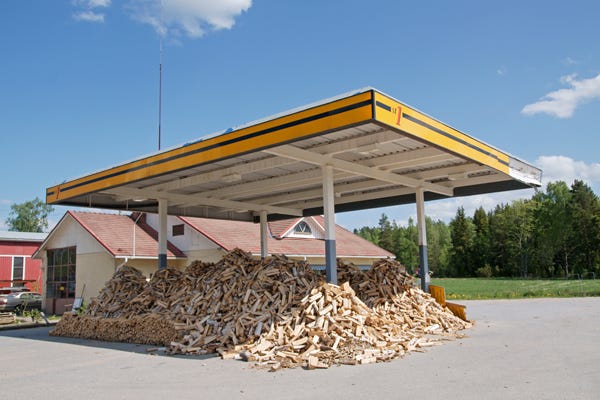1 Week, 7 Stories #34
Policy, pancake politics, and grizzly bears caught up in the middle
Every edition features 7 stories, from the past week. I’ll draw on my background in media, journalism, agriculture, biotech, and renewable energy to come up with an interesting selection and to offer some context.
The summer heat has kicked into high gear and with outdoor water restrictions still in place in Calgary, gardens and yards are wilting away. I’ll kick off with the story of a man from Mississauga who got the attention of The Guardian in the UK with a garden that can beat the heat.
Years (and years) ago, a biology prof of mine at the University of Calgary was way ahead of the trend towards more natural gardens or re-wilding gardens. He had a few complaints from the neighbours, but for the most part got away with his unique approach to yard design while also using it to teach his students something about biodiversity.
Not so for Wolf Ruck who was a canoe-kayak competitor for Canada in the 1968 Olympics. Now instead of skimming over the water, he is in hot water with the City of Mississauga for being very contrary and letting his garden grow. And grow. He is not alone. A couple in Smith Falls Ontario went down the same garden path and found themselves with similar problems when they were cited for bylaw violations. Looking at the pictures in this article from Rewilding Magazine nothing qualifies as an eyesore from my perspective.
Not giving into to the idea of a manicured lawn can be a tough decision – especially if it means your yard stands out on the block and to some eyes at least, perhaps for the wrong reasons. As you’ll hear in this interview from The Current on CBC last year, our old notions of the ideal front yard can be biodiversity killers. More natural landscaping needs some planning and some effort, so it doesn’t become an out-of-control mess. It also means being prepared to “come up against local regulations”.
When properly done, a natural yard and garden not only looks good, but it also has more biodiversity, can better withstand climate extremes, be more productive, store carbon in the soil, use less water, and reduce dependence on pesticides and fertilizers.
Your chance to contribute to building healthy ecosystems.
Boehringer Ingelheim is a huge pharmaceutical company (more accurately a group of companies) which has been around for 140 years. It is the world’s largest private pharmaceutical company and the Boehringer family is still one of the 3 owners. It made the news this week, not for advances in drug development, but for opening a biomass power plant at its Ingelheim site in Germany. According to a media release, the new plant will save around 50,000 tons of CO2 per year. The ultimate goal is to produce 95% of the energy for the site from renewable sources.
What seemed to be missing from the media release were specifics on the sources of the biomass. It says the Rhine-Main area, but that is largely a metropolitan area so I’m not sure what the full answer is. Biomass is waste or unsellable wood from logging, hurricane and tornado debris, agricultural waste such nut shells or oat hills, sawdust, or any other left-over plant material that can be burned. Most of which Canada has in abundance. The Atikokan Generating Station in Ontario was converted from coal to biomass and is now the largest 100% biomass-fueled power plant in North America so we have proved our potential.
Canada is involved in the research activities of the International Energy Agency Bioenergy organization which is a group of 17 countries sharing their expertise in bioenergy and how it can best be put to work. One of the side benefits of biomass energy production the group has cited is that the waste material is not left to rot and produce methane or burned off which releases smoke and ash into the air. Biomass for energy production on the other hand is burned in airtight chambers with filters to prevent emissions.
Biomass is not without its critics, especially when it comes to the source of the biomass. A BBC investigation in 2022 found that the Canadian company supplying Britain’s biggest power station with wood pellets was making them from old-growth forests in BC, and not just from waste wood and sawdust. The company operating the power plant was receiving UK green energy subsidies which is also a sore point for biomass energy. Using biomass is not simply stuffing a woodstove with kindling and logs like you do in your fireplace. It must first be manufactured into pellets which can be fed into the biomass burners which may not be located anywhere near the fuel source. Late last year, the Government of Ontario announced a $1.6 million investment in a new Forest Biomass Program which will go to companies to develop the technology, increase efficiency of pellet production, and ensure biomass fuel supplies. Quebec made a similar $1.5 million investment in May to the Consortium for Research and Innovation in Industrial Bioprocesses in Quebec.
In the UK, the National Audit Office said that after two decades and £20bn (about 34 billion Cdn) worth of investments, the government cannot guarantee that power generators were complying with sustainability requirements. (Go back to that BBC story mentioned above!)
Renewable energy is needed. No question. Making sure we get it right is important and biomass is facing the same scrutiny other energy sources receive.

There is politics and there is policy.
On June 17th the Government of Alberta played both when it made a significant change to regulations under the Wildlife Act. That’s policy. That they made the change by Ministerial order with no media release and no consultation is politics. And no wonder, because allowing Alberta trophy hunters to once again shoot grizzly bears is bad politics and the government is getting an earful from across the province.
The Minister of Alberta Forestry and Parks is the Honourable Todd Loewen and his Mandate Letter refers to maintaining biodiversity, grassland management, and many other aspects of forestry and parks in the province. It certainly doesn’t hint at making moves such as this under the public radar. The letter also does not suggest he have a plan to separate his day job from his business as owner of Red Willow Outfitters which offers guided deer hunts, moose hunts, and yes, bear hunts. The website has pictures of grinning hunters and dead animals under a banner which reads “Make Your Dream Hunt A Reality In Alberta, Canada”.
The government has offered several reasons for why grizzly hunting is back, one of which is that grizzlies kill livestock. When I had a small ranch in the Foothills northwest of Calgary, one of my neighbours was part of a family who had ranched in the area for a couple of generations. He used to say that if you have livestock, you have deadstock, and he accepted that our other neighbours included bears and cougars. Loses from predators are inevitable and ranchers can receive some compensation for their losses. They also had the option previously of calling in an Alberta Fish and Wildlife officer and getting permission to hunt problem predators. The new regulations however now allow a hunter from an application list to receive a special license to come in and conduct the hunt. I should note that during a CBC interview with Minister Loewen he said this was not an open hunt and indeed it is not. Had the new regulations been brought in publicly and with suitable communication the backlash may not have been as sharp. That is bad politics and policy.
According to media reports Alberta Forestry and Parks says there have been “897 counts of livestock losses since 2016”, but even The Guardian in the UK is looking at the decision and wondering how many of those kills were due to grizzly bears.
In Alberta there are about 4.5 million head of cattle and just over 160,000 resident hunters. There are fewer than a thousand grizzly bears and they are on the endangered species list.
The Minister in charge seems to have has set his sights on protecting the numbers that least need his help.
Not quite done with politics for this edition.
It is Stampede Week in Calgary with numerous Stampede breakfasts that have become part of ‘Pancake Politics’. Politicians flipping flapjacks and lobbyists lying in wait in all the right places to get a few minutes of time with bureaucrats and elected officials from all levels of government.
If you are in a business prone to being tossed about by shifting political winds, if you are a not-for-profit seeking government funding, or an organization engaging in social activism, chances are you already do some lobbying - whether not you have taken the necessary steps to register provincially or federally. Danielle Smith, was a lobbyist up until she became Premier Smith in 2022, and Alberta Views magazine described her in May as “once and always working for oil and gas”.
Lobbying is not such a bad idea. An old idiom says, “you can’t fight city hall” and there is no doubt that it is challenging to navigate bureaucracy, politicians, and changing policies and regulations. You need expertise to get the right message, at the right time, and to the right people if you are going to effect change. However, it should be up front and transparent unlike this recent example.
What lobbyists are up to at any given time can offer some interesting (and sometimes perplexing) insights. iPolitics does a regular ‘Lobby Watch’ and this week’s watch included a mix.
We have heard many of the concerns about changes to capital gains inclusion rate and the Grain Growers of Canada has that in mind when it comes to intergenerational transfers and family farms and was lobbying the federal government for changes.
The Coffee Association of Canada is a recent registrant, saying it wanted to “educate” government officials about the benefits of coffee consumption in Canada.
Nikola Corporation is a US based company focused on battery-electric and hydrogen fuel cell electric trucks. It wants to find a place in Canada’s national hydrogen strategy.
Also according to Lobby Watch, Adobe wants to “discuss AI and Copyright”.
Keep some of those in mind as you read your news feed over the next several months.
The quarterly Alberta Lobbyist Registry Report is also an interesting snapshot. For the period ending June 30th, Health led the top 10 list of subjects being lobbied and Climate tied with Taxes and Finance for the 10th spot. The top provincial entity was Alberta Health Services which reflects the top subject matter.
If you want to see how all this fits together, the Investigative Journalism Foundation analyzed “just who knows whom in Ottawa” and created an interactive graphic that says it all.
An article in the Wall Street Journal points to fusion as a clean-energy dream that could deliver “almost-limitless energy”. It also points out that in the high-tech race to bring the elusive energy source to reality, the United States is losing ground to China.
The Fusion Energy Council of Canada describes fusion as the “energy source of the Sun and stars” in which hydrogen nuclei collide, fuse into heavier helium atoms and release tremendous amounts of energy. Hence “fusion” as opposed to “fission” used in current nuclear-powered energy sources.
There is a catch to making it happen here on terra firma. You need to heat those hydrogen atoms to around150 million degrees Celsius (270 million Fahrenheit) under pressures billions of times more than Earth’s atmosphere.
China is investing $1.5 billion a year and working around the clock to find solutions to the challenges. The US is pushing for commercial fusion within the decade and the latest budget ask is $1 billion. Meanwhile the Canadian Nuclear Society wants to be a “world player” in 5 years and a leader in 10. The roadmap for Canada released in June is really no more than that. A map. With no money to complete the journey.
Skeptics have said that ‘fusion is always 30 years away and always will be”, but an open-source article in the Journal of Fusion Energy says that it is closer to reality. 17.8 years away to be precise. The technology requires extensive extraction and processing of lithium, tungsten, cobalt, mercury, and deuterium which is going to cause problems before we ever reach widespread commercial production.
Scientific American is not convinced of the projections and says it may be possible by 2050 which may put its arrival well after fixing our climate problem is out of reach. Just last week a story in LiveScience said that a $28 billion fusion reactor has finally been completed in France, but 2039 is the earliest possible date for it to be fired up.
Mark that date on your calendar for the next disaster movie. A planet already overheating while everyone holds their collective breath waiting for scientists to flick the switch on turbulent coils of plasma at temperatures as hot as the sun. Could be interesting.
Carbon capture is never far from the news because of its potential for reducing carbon emissions. This week Strathcona Resources said it was partnering with the Canada Growth Fund to capture and store carbon from its thermal oilsands projects in Alberta and Saskatchewan. According to the company’s media release the project will capture 2 million of the 3 million tonnes of CO2 emissions from its heavy oil and bitumen projects, but there are roughly 80 million tonnes of CO2 emitted every year by oilsands projects.
The Government of Alberta claims that the province has the ideal geology for carbon capture and storage so we have that much in our favour. A report earlier this year from Clean Prosperity Canada concluded that Canada overall has the geological potential to hold 389 gigatonnes (that’s 389 billion tonnes to keep some of the numbers consistent) of CO2 emissions. A Reuters story pointed out that there are 42 operational carbon capture storage projects in the world that together could capture only 49 million tonnes of the world’s 37 billion tonnes of annual CO2 emissions. To be sequestered, CO2 needs to be separated from other gases, compressed, chilled, transported under pressure to the storage site, and then injected into the ground. Once safely in the ground and out of the way, we don’t have any long-term experience on how it will change the properties of the rock and surrounding formation. A new modelling tool to monitor and understand what is happening was outlined in a Nature Communications paper in June which should help ensure the safety of the process.
The MIT Climate Portal offers some re-assurance by saying that oil and gas deposits have been trapped underground for millions of years, so we have to choose our carbon storage sites carefully to duplicate that reliability.
3D printing has come a long way since the days of being an expensive way to print little toys. Now bioprinting can print living cells for tissue engineering, skin and bone grafts, and 3D organs. For instance last year, a 3D windpipe was transplanted into a patient who had to have part of her windpipe removed due to cancer. Also in 2023 a young woman born without an outer ear had one 3D printed using her own cartilage and it was implanted successfully.
This week the federal government and the BC government kicked in $72.75 million as part of a $200 million project by Aspect Biosystems to take another step in 3D bioprinting. Last year the company was added to Fast Company’s Next Big Things in Tech list for its bioprinted pancreatic tissue and the latest announcement shows it was a good choice. Aspect is a Canadian biotech company that grew out of a University of British Columbia spinoff and one of the cornerstones of the project is a manufacturing plant which will be built in Vancouver. The project will add 200 new jobs to Aspect’s workforce according to a BC government media release and will certainly add more talent and capacity to the province’s growing life sciences sector.
A pre-proof paper from this month’s Additive Manufacturing Frontiers takes a retrospective look at the process and notes that there are still limitations to large-scale and commercially viable applications to turn the potential of the technology into clinical use.
What was once a dream of researchers is now one step closer to being part of medical technology.
Read, comment, subscribe, and share this newsletter.
I’m available for contract and freelance work with not-for-profits and charities. With 40 years of experience behind me and lots of time ahead of me, I’m here to help you make a difference in your media relations, public relations, and general communications needs.
I also have a Substack newsletter which will include 1 Week, 7 Stories and other new material over the weeks to come.
And just because, how about digging into the photo album for a




